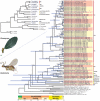Testing the emergence of New Caledonia: fig wasp mutualism as a case study and a review of evidence
- PMID: 22383982
- PMCID: PMC3285151
- DOI: 10.1371/journal.pone.0030941
Testing the emergence of New Caledonia: fig wasp mutualism as a case study and a review of evidence
Abstract
While geologists suggest that New Caledonian main island (Grande Terre) was submerged until ca 37 Ma, biologists are struck by the presence of supposedly Gondwanan groups on the island. Among these groups are the Oreosycea fig trees (Ficus, Moraceae) and their Dolichoris pollinators (Hymenoptera, Agaonidae). These partners are distributed in the Paleotropics and Australasia, suggesting that their presence on New Caledonia could result from Gondwanan vicariance. To test this hypothesis, we obtained mitochondrial and nuclear markers (5.3 kb) from 28 species of Dolichoris, used all available sequences for Oreosycea, and conducted phylogenetic and dating analyses with several calibration strategies. All our analyses ruled out a vicariance scenario suggesting instead that New Caledonian colonization by Dolichoris and Oreosycea involved dispersal across islands from Sundaland ca 45.9-32.0 Ma. Our results show that successful long-distance dispersal of obligate mutualists may happen further suggesting that presence of intimate mutualisms on isolated islands should not be used as a priori evidence for vicariance. Comparing our results to a review of all the published age estimates for New Caledonian plant and animal taxa, we showed that support for a vicariant origin of the island biota is still lacking. Finally, as demonstrating a causal relationship between geology and biology requires independent evidence, we argue that a priori assumptions about vicariance or dispersal should not be used to constrain chronograms. This circular reasoning could lead to under or overestimation of age estimates.
Conflict of interest statement
Figures


Similar articles
-
An extreme case of plant-insect codiversification: figs and fig-pollinating wasps.Syst Biol. 2012 Dec 1;61(6):1029-47. doi: 10.1093/sysbio/sys068. Epub 2012 Jul 30. Syst Biol. 2012. PMID: 22848088 Free PMC article.
-
New Caledonia: a very old Darwinian island?Philos Trans R Soc Lond B Biol Sci. 2008 Oct 27;363(1508):3309-17. doi: 10.1098/rstb.2008.0122. Philos Trans R Soc Lond B Biol Sci. 2008. PMID: 18765357 Free PMC article. Review.
-
Molecular dating and biogeography of fig-pollinating wasps.Mol Phylogenet Evol. 2009 Sep;52(3):715-26. doi: 10.1016/j.ympev.2009.05.028. Epub 2009 Jun 13. Mol Phylogenet Evol. 2009. PMID: 19500682
-
Recent advances in New Caledonian biogeography.Biol Rev Camb Philos Soc. 2019 Jun;94(3):957-980. doi: 10.1111/brv.12485. Epub 2018 Dec 6. Biol Rev Camb Philos Soc. 2019. PMID: 30523662 Review.
-
Updating the Phylogenetic Dating of New Caledonian Biodiversity with a Meta-analysis of the Available Evidence.Sci Rep. 2017 Jun 16;7(1):3705. doi: 10.1038/s41598-017-02964-x. Sci Rep. 2017. PMID: 28623347 Free PMC article.
Cited by
-
Diversification and coevolution in brood pollination mutualisms: Windows into the role of biotic interactions in generating biological diversity.Am J Bot. 2016 Oct;103(10):1783-1792. doi: 10.3732/ajb.1600056. Epub 2016 Oct 7. Am J Bot. 2016. PMID: 27765775 Free PMC article. Review.
-
Integrative taxonomy of New Caledonian beetles: species delimitation and definition of the Uloma isoceroides species group (Coleoptera, Tenebrionidae, Ulomini), with the description of four new species.Zookeys. 2014 Jun 12;(415):133-67. doi: 10.3897/zookeys.415.6623. eCollection 2014. Zookeys. 2014. PMID: 25009426 Free PMC article.
-
Beyond fossil calibrations: realities of molecular clock practices in evolutionary biology.Front Genet. 2014 May 26;5:138. doi: 10.3389/fgene.2014.00138. eCollection 2014. Front Genet. 2014. PMID: 24904638 Free PMC article.
-
The metal hyperaccumulators from New Caledonia can broaden our understanding of nickel accumulation in plants.Front Plant Sci. 2013 Jul 26;4:279. doi: 10.3389/fpls.2013.00279. eCollection 2013. Front Plant Sci. 2013. PMID: 23898341 Free PMC article.
-
Transoceanic origin of microendemic and flightless New Caledonian weevils.R Soc Open Sci. 2017 Jun 7;4(6):160546. doi: 10.1098/rsos.160546. eCollection 2017 Jun. R Soc Open Sci. 2017. PMID: 28680653 Free PMC article.
References
-
- Pascal M, Richer de Forges B, Le Guyader H, Simberloff D. Mining and other threats to the New Caledonia biodiversity hotspot. Conserv Biol. 2008;22:498–499. - PubMed
Publication types
MeSH terms
LinkOut - more resources
Full Text Sources

